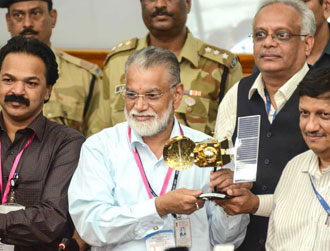Tuesday’s successful launch of the Mangalyaan Mars orbiter has the world marveling at the cost-efficiency with which the Indian Space Research Organization (ISRO) has become the world’s 4th to successfully launch a mission to Mars.
It took ISRO just 15 months and 4.5 billion rupees ($73 mil.) to pull off a feat achieved so far by only the US, Russia and the EU. What’s even more impressive is that the Mangalyaan mission cost only a sixth of NASA’s MAVEN Mars orbiter mission scheduled to launch on the 18th of the month.
The Mangalyaan lifted off atop the homegrown Polar Satellite Launch Vehicle (PSLV-C25) rocket from the Satish Dhawan Space Center near the town of Doordarshan on the east-coast island of Sriharikota. Unlike the failed Chinese Mars probe mission launched in 2011, the Mangalyaan achieved the correct elliptical orbit. It will maintain the orbit for 25 days while slowly gaining speed until it leaves earth orbit for Mars on December 1.
The Mangalyaan is scheduled to enter Mars orbit next September 24. Its mission is to conduct five major studies from orbit, including seeking signs of methane, a gas seen as evidence that conditions once existed to support life. NASA’s Curiosity rover had failed to detect any methane. ISRO scientists argue that NASA had also failed to detect signs of water on the moon but the ISRO’s 2008 lunar probe Chandrayaan-1 had confirmed water molecules in the lunar soil.
Aside from any scientific achievements that may come of the Indian Mars mission, the nation has already earned international respect for its remarkable cost-efficiency. The Mangalyaan mars orbiter cost only $25 million, with the rest of the $73 million going toward improvements to the launch facility, the ground station and relay upgrades to be used for future ISRO projects. ISRO managed to assemble the satellite at a tenth the cost of NASA’s Maven probe which should reach Mars at about the same time as Mangalyaan.
ISRO’s budget for 2012-13 was $700 million, only the ninth largest among the world’s space powers while it is ranked several notches higher in terms of achievement. One way ISRO has reduced costs is by defraying operating costs by earning about $300 million through the sale of satellite launches, satellite imaging services and other services.
By comparison, the US space budget in 2011 was $43 billion while China’s is believed to be around $1.3 bil., over twice the official figure of $500 mil. India hasn’t yet tried to match China’s successes in orbiting taikonauts and performing dockings and spacewalks. On the other hand, China’s Mars mission, which used a Russian rocket, never left earth orbit.
The cost-efficiency of India’s space program will help it become even more efficient by securing a bigger slice of the $304 billion global market for space launches. It has also given Indians a much-needed sense of national pride at a time when the nation’s economic prospects had begun to dim.


